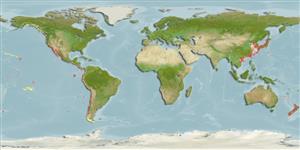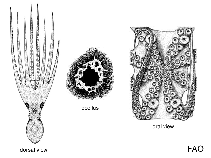Octopus bimaculatus Verrill, 1883
California two-spot octopus| Native range | All suitable habitat | Point map | Year 2050 |

|
| This map was computer-generated and has not yet been reviewed. |
| Octopus bimaculatus AquaMaps Data sources: GBIF OBIS |
Classification / Names Common names | Synonyms | CoL | ITIS | WoRMS
Cephalopoda | Octopoda | Octopodidae
Environment: milieu / climate zone / depth range / distribution range Ecology
Benthic; depth range 0 - 50 m (Ref. 96968). Subtropical; 35°N - 20°N, 121°W - 105°W (Ref. 96968)
Distribution Countries | FAO areas | Ecosystems | Occurrences | Introductions
Eastern Central Pacific: from Point Concepcion, California to Mexico.
Length at first maturity / Size / Weight / Age
Maturity: Lm ? range ? - ? cm Max length : 122 cm TL male/unsexed; (Ref. 123051); max. published weight: 3.0 kg (Ref. 96968)
Life cycle and mating behavior Maturity | Reproduction | Spawning | Eggs | Fecundity | Larvae
Main reference
References | Coordinator | Collaborators
Jereb, P., C.F.E. Roper, M.D. Norman and J.K. Finn 2014 Cephalopods of the world. An Annotated and Illustrated catalogue of Cephalopod species known to date. Vol. 3. Octopods and vampire squids. FAO Species Catalogue for Fishery Purposes 3(4):370p. (Ref. 96968)
IUCN Red List Status
(Ref. 130435: Version 2025-1)
CITES status (Ref. 108899)
CMS (Ref. 116361)
Threat to humans
Human uses
| FishSource |
Tools
More information
Max. ages / sizes
Length-weight rel.
Length-length rel.
Length-frequencies
Mass conversion
Abundance
Internet sources
BHL | BOLD Systems | CISTI | DiscoverLife | FAO(Publication : search) | Fishipedia | GenBank (genome, nucleotide) | GloBI | Gomexsi | Google Books | Google Scholar | Google | PubMed | Tree of Life | Wikipedia (Go, Search) | Zoological Record



